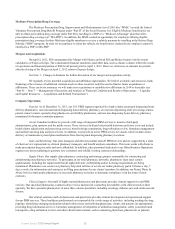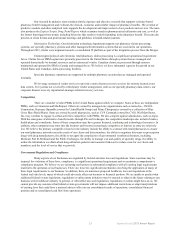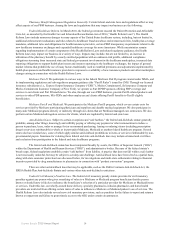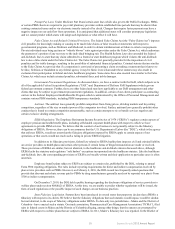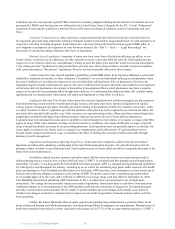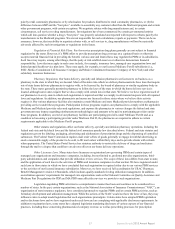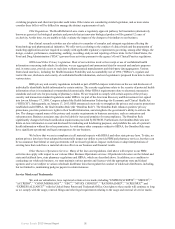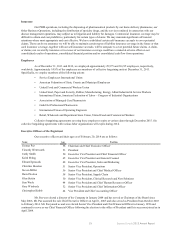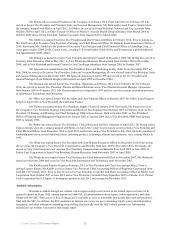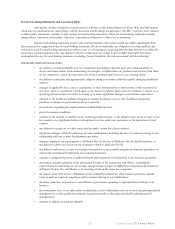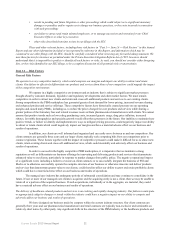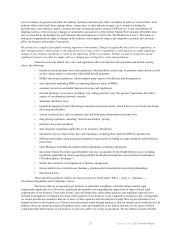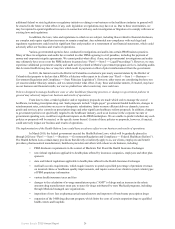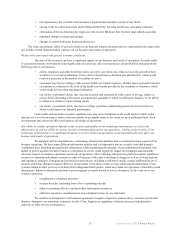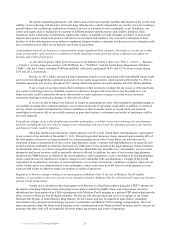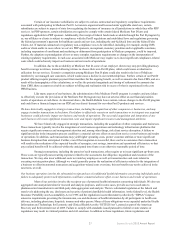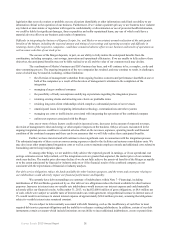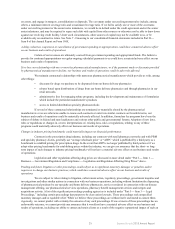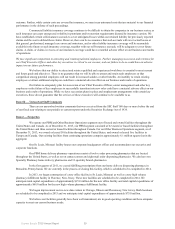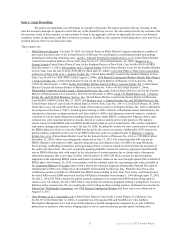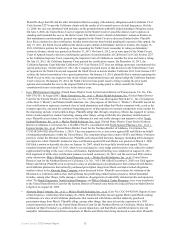Express Scripts 2013 Annual Report Download - page 22
Download and view the complete annual report
Please find page 22 of the 2013 Express Scripts annual report below. You can navigate through the pages in the report by either clicking on the pages listed below, or by using the keyword search tool below to find specific information within the annual report.
Express Scripts 2013 Annual Report 22
• results in pending and future litigation or other proceedings which could subject us to significant monetary
damages or penalties and/or require us to change our business practices, or the costs incurred in connection
with such proceedings
• our failure to attract and retain talented employees, or to manage succession and retention for our Chief
Executive Officer or other key executives
• other risks described from time to time in our filings with the SEC
These and other relevant factors, including those risk factors in “Part I — Item 1A — Risk Factors” in this Annual
Report and any other information included or incorporated by reference in this Report, and information which may be
contained in our other filings with the SEC, should be carefully considered when reviewing any forward-looking statement. We
note these factors for investors as permitted under the Private Securities Litigation Reform Act of 1995. Investors should
understand that it is impossible to predict or identify all such factors or risks. As such, you should not consider either foregoing
lists, or the risks identified in our SEC filings, to be a complete discussion of all potential risks or uncertainties.
Item 1A — Risk Factors
General Risk Factors
We operate in a very competitive industry, which could compress our margins and impair our ability to attract and retain
clients. Our failure to effectively differentiate our products and services from those of our competitors could magnify the impact
of the competitive environment.
We operate in a highly competitive environment and an industry that is subject to significant market pressures
brought about by customer demands, legislative and regulatory developments and other market factors. We must remain
competitive in order to attract new clients and retain and cross-sell additional products and services to our existing clients.
Strong competition in the PBM marketplace has generated greater client demand for lower pricing, increased revenue sharing
and enhanced product and service offerings. These competitive factors have historically created pressure on our operating
margins and caused many PBMs, including us, to reduce the prices charged for core products and services while sharing a
greater portion of the formulary fees and related revenues received from pharmaceutical manufacturers with clients. We cannot
assume that positive trends such as lower drug purchasing costs, increased generic usage, drug price inflation, increased
rebates, favorable demographics and specialty growth would offset these pressures in the future. Our inability to maintain these
positive trends, or failure to identify and implement new ways to mitigate pricing pressures, could negatively impact our ability
to attract or retain clients which could negatively impact our margins and have a material adverse effect on our business and
results of operations.
In addition, our clients are well informed and organized and can easily move between us and our competitors. Our
client contracts are generally three years and our larger clients typically seek competing bids from our competitors prior to
contract expiration. These factors together with the impact of competitive pressures could make it difficult for us to attract new
clients, retain existing clients and cross-sell additional services, which could materially and adversely affect our business and
results of operations.
In order to succeed in the highly competitive PBM marketplace, it is imperative that we maintain a strong
reputation as well as differentiate our business offerings by innovating and delivering products and services that demonstrate
enhanced value to our clients, particularly in response to market changes from public policy. The negative reputational impact
of a significant event, including a failure to execute on client contracts or to successfully integrate the business of ESI and
Medco or to otherwise successfully operate the complex structure of our business or otherwise innovate and deliver products
and services that demonstrate greater value to our clients, could therefore affect our ability to grow and retain profitable clients
which could have a material adverse effect on our business and results of operations.
The managed care industry has undergone periods of substantial consolidation and may continue to consolidate in the
future. If one or more of our managed care clients is acquired, and the acquiring entity is not a client, then we may be unable to
retain all or a portion of the acquired business. If such acquisitions, individually or in the aggregate, are material, they could
have a material adverse effect on our business and results of operations.
The delivery of healthcare-related products and services is an evolving and rapidly changing industry. Our failure to anticipate
or appropriately adapt to changes or trends within the industry could have a negative impact on our ability to compete and
adversely affect our business and results of operations.
We have designed our business model to compete within the current industry structure. Our client contracts are
generally three years and our pharmaceutical manufacturer and retail contracts are typically non-exclusive and terminable on
relatively short notice by either party. Any significant shifts in the structure of the PBM industry or the healthcare products and


